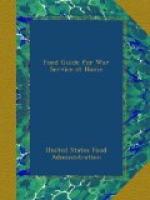All the countries have definite milk rations for their children. These rations would be adequate if they could be obtained, but many times they fall short. Every effort is made to treat all children, rich and poor, alike. The price of milk is regulated, but parents who cannot afford to buy it are given it free or at cost. Dried and condensed milk are used where they can be obtained and fresh milk cannot. Thousands of tons of condensed milk have been sent over from America. There has been scarcely a child born in the north of France and none in Belgium whose continued life during all that period has not been dependent upon American condensed milk. At one time the Ministry of Food in Great Britain, anticipating a milk shortage in the winter bought large quantities of dried milk for distribution by local health committees and infant welfare societies.
In Belgium, in spite of the misery of the people, fewer young children are dying than before the war, because of the milk and bread and care that they get at the “soupes” and children’s canteens. But in Poland, Roumania, and Serbia, thousands and tens of thousands of babies and young children have died since the war for lack of milk and other food.
Grown people should use milk and appreciate that it is far more than a beverage. Comparing it with tea and coffee is not sensible. The idea that food is “something to chew” breaks down completely when milk is considered. “Milk is both meat and drink.”
THE VALUABLE CONSTITUENTS OF MILK
What gives milk its unique value? It must contain especially valuable substances, since it is an adequate food for the young for several months after birth and is one of the most important constituents of a grown person’s diet.
It contains protein of a kind more valuable, especially for growing children, than that of most other foods. Milk protein separates out when milk sours and is the familiar cottage-cheese. Because of it, milk, whole or skim, is a valuable meat substitute. When we drink milk, therefore, we need less meat.
It contains fat. A pint of milk has a little more than half an ounce—the same amount as an ordinary serving of butter. By drinking milk we can save fat as well as meat.
Milk-sugar is also present, more or less like ordinary sugar, but not so sweet. The sugar, the fat, and part of the protein burn in the body, giving the energy needed for the body’s activities. A pint gives as much fuel as 4 eggs, or half a pound of meat, or 3 or 4 large slices of bread. Although bread is cheaper fuel than milk, its economy compared with meat or eggs is obvious. The pint of milk costs usually about 7 cents, while the eggs and meat cost at least two or three times as much. The economy of substituting milk for at least part of the meat in the diet is plain. It is the advice of an expert to “let no family of 5 buy meat till it has bought 3 quarts of milk.”




